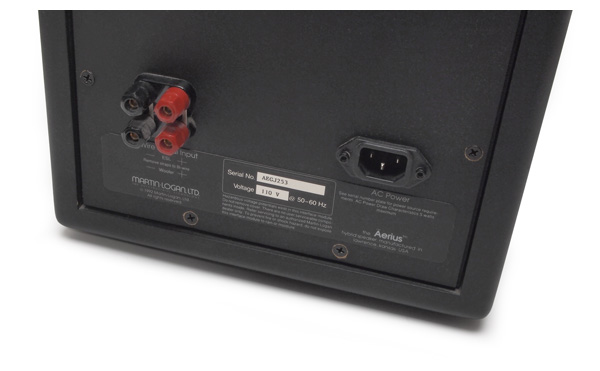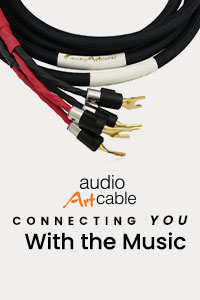MartinLogan Aerius i Loudspeaker
 MartinLogan’s full-range CLS is the speaker often cited for gaining the company a legion of fans, but if you dig a bit deeper, you’ll find another speaker with similar loyalty—the Aerius, which later became the Aerius i. Speaking as someone who’s had prolonged experience with both models, the CLS’ larger-than-life soundstage and breathtaking transparency was tough to beat, especially as vinyl headed for its sunset and many made the move to compact disc. Indeed, the CLS possessed so much resolution that it took only about 30 seconds to convince the uninitiated that the CD was no match for the LP.
MartinLogan’s full-range CLS is the speaker often cited for gaining the company a legion of fans, but if you dig a bit deeper, you’ll find another speaker with similar loyalty—the Aerius, which later became the Aerius i. Speaking as someone who’s had prolonged experience with both models, the CLS’ larger-than-life soundstage and breathtaking transparency was tough to beat, especially as vinyl headed for its sunset and many made the move to compact disc. Indeed, the CLS possessed so much resolution that it took only about 30 seconds to convince the uninitiated that the CD was no match for the LP.
When I moved to a smaller living space in the late 80s, the CLS had to go, and I temporarily ended up in the Acoustat camp. While the 1+1s were pleasant, they lacked the detail that made the MartinLogan speakers intoxicating. But then, in 1992, MartinLogan introduced the Aerius, which mated an 8-inch dynamic woofer to an electrostatic panel that was about 30% smaller than the one fitted to its larger Sequel. The Aerius was less expensive as well, costing just $1,995. The audiophile press raved; Stereophile’s John Atkinson claimed the woofer/panel integration to be “virtually flawless.”
Building on the success of the Aerius, the Aerius i came out in 1996 and remained in production until 2000. The i featured an improved crossover network, which lowered the critical crossover frequency from 500hz to 450hz and allowed the ESL panel handle more of the critical midrange frequencies. The new model was an improvement in every way, but did feature a lower minimum impedance (2 ohms with the Aerius; 1.7 ohms with the Aerius i) that made them tougher to drive with low-powered tube amplifiers.
The pair of Aerius i speakers featured here were supplied by MartinLogan for a comparison with its new ElectroMotion speaker that’s featured on page XXX of this issue. After allowing the panels to charge for a full day, the Aerius i sounded just as I remembered, featuring a smooth upper register, excellent integration between woofer and the ESL panel, and solid bass performance. While it’s been close to 20 years since these speakers were in my system, I’m as astonished by their performance now as I was the day I first uncrated them. I felt they were an amazing value for $2,000 then; considering a clean used pair fetches only $700-$900, the i makes for an excellent building block for a high-performance albeit moderately priced system.
MartinLogan’s ESL panels have a finite lifespan of about 15 years, so if you plan on hanging on to the Aerius for any length of time, budget for a panel replacement. This requires both DIY skills and between $500 and $700 for raw materials. The panels are still available from MartinLogan and are produced at their Kansas facility. Unless the previously owned speakers you purchase are flawless, plan on exchanging the panels in the near future. Negotiate the price accordingly.
Performance the modestly powered tube amplifiers at my disposal was mixed. The CJ MV-50 and PrimaLuna Dialog 4 with EL34 output tubes (and about 35-45 watts per channel) had no problem driving the Aerius i, yet the vintage Dynaco Stereo 70 struggled, offering boomy and uncontrolled bass as well as a rolled-off high end. Note to tube aficionados: Make certain you can audition the speakers with your amplifier; the more power, the better and if your amplifier offers a 2-ohm tap, that will help.
While these speakers work well with most tube amplification, I’ve always achieved the best balance of musicality, HF extension, and bass control with a vacuum-tube preamplifier and high-current solid-state power amplifier. Should you be assembling a vintage/budget system, there’s a plethora of great amplifiers from which to choose in the $1,000-$2,000 range. But remember, these speakers are very revealing and will benefit from quality over quantity when it comes to power.
The Aerius i had no trouble capturing the delicacy in Loudness’ “In My Dreams” from the Japanese rock legends’ Unleashed in the East album. The song features layers of phased and flanged guitars, which prove a treat for anyone that appreciates pinpoint imaging. An equally intriguing effect came courtesy of Lou Reed’s live Metal Machine Trio album, Creation of the Universe. The record’s atmospheric, edgy quality burst to life on these vintage speakers. Of course, if solo vocalists and acoustic guitarists are your bag, you will be thrilled—that’s the kind of music for which ESL panels were designed.
In fact, harder-edged rock was the only area in which the Aerius fell short. Even swapping the tube amplifiers for the formidable solid-state Burmester 911 mk. 3 failed to deliver the goods. Cranking up Triumph’s Rock and Roll Machine proved fruitless. As the volume levels approached realistic levels, the experience brought my Aerius journey full circle. I remembered why I had to ultimately move on from the pair of speakers that had been my staple for so many years. Joni Mitchell, yes; Jimi Hendrix, no.
Defying Convention
Critics told MartinLogan that a speaker incorporating a dynamic woofer and electrostatic panel couldn’t be done. Yet MartinLogan has continued to refine its hybrid ESL/dynamic woofer concept to the point where on the company’s current speakers, you can play Metallica at realistic levels, increasing the dynamic range and improving the blend between the disparate drivers. Each new model performs better than its predecessor.
But the Aeirus and Aerius i marked a turning point. They nailed the recipe, winning major accolades and loyal fans in the process. Revisiting these speakers only reinforces their excellence. Need a great anchor for a burgeoning high-end system? Look no further. -Jeff Dorgay







